Program Planning and Evaluation: Diabetes Health Program, PUBH2007
VerifiedAdded on 2023/01/16
|13
|2141
|88
Report
AI Summary
This report presents a comprehensive health promotion program plan designed to tackle Type 2 Diabetes among Aboriginal and Torres Strait Islander people in the Playford Council Area. The program focuses on promoting healthy eating habits through a community green garden and food hub initiative, aiming to increase fruit and vegetable consumption. The plan outlines project goals, SMART objectives, and detailed strategies for resource collection, behavior change, and community engagement. It also includes process indicators and data collection methods to monitor progress. The evaluation section details the methods for assessing the project's impact, involving qualitative and quantitative data collection through interviews and surveys. Ethical considerations and stakeholder involvement are also addressed. The project's success relies on active cooperation, addressing the high rates of nutrition-related issues, and promoting sustainable health improvements within the community.
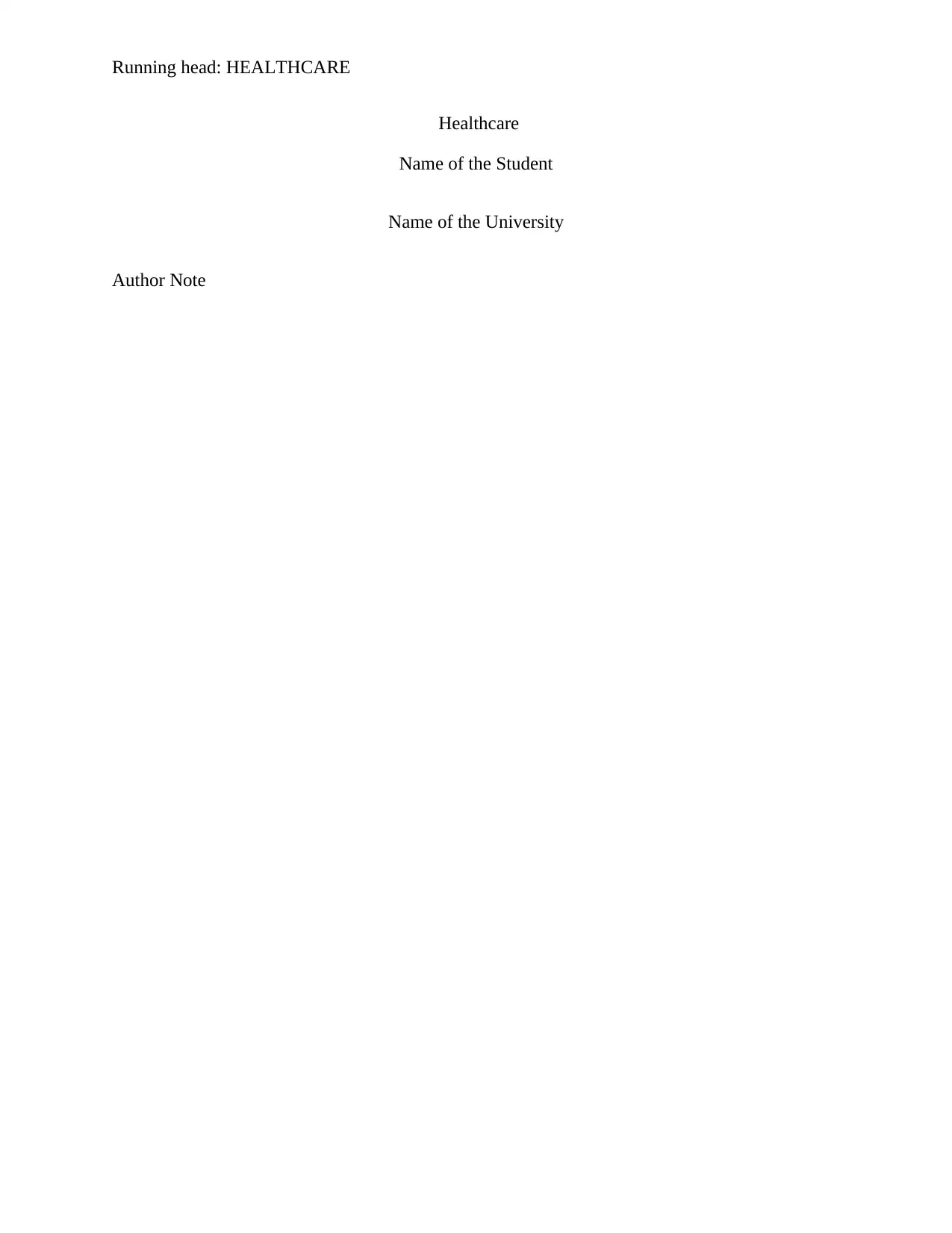
Running head: HEALTHCARE
Healthcare
Name of the Student
Name of the University
Author Note
Healthcare
Name of the Student
Name of the University
Author Note
Paraphrase This Document
Need a fresh take? Get an instant paraphrase of this document with our AI Paraphraser
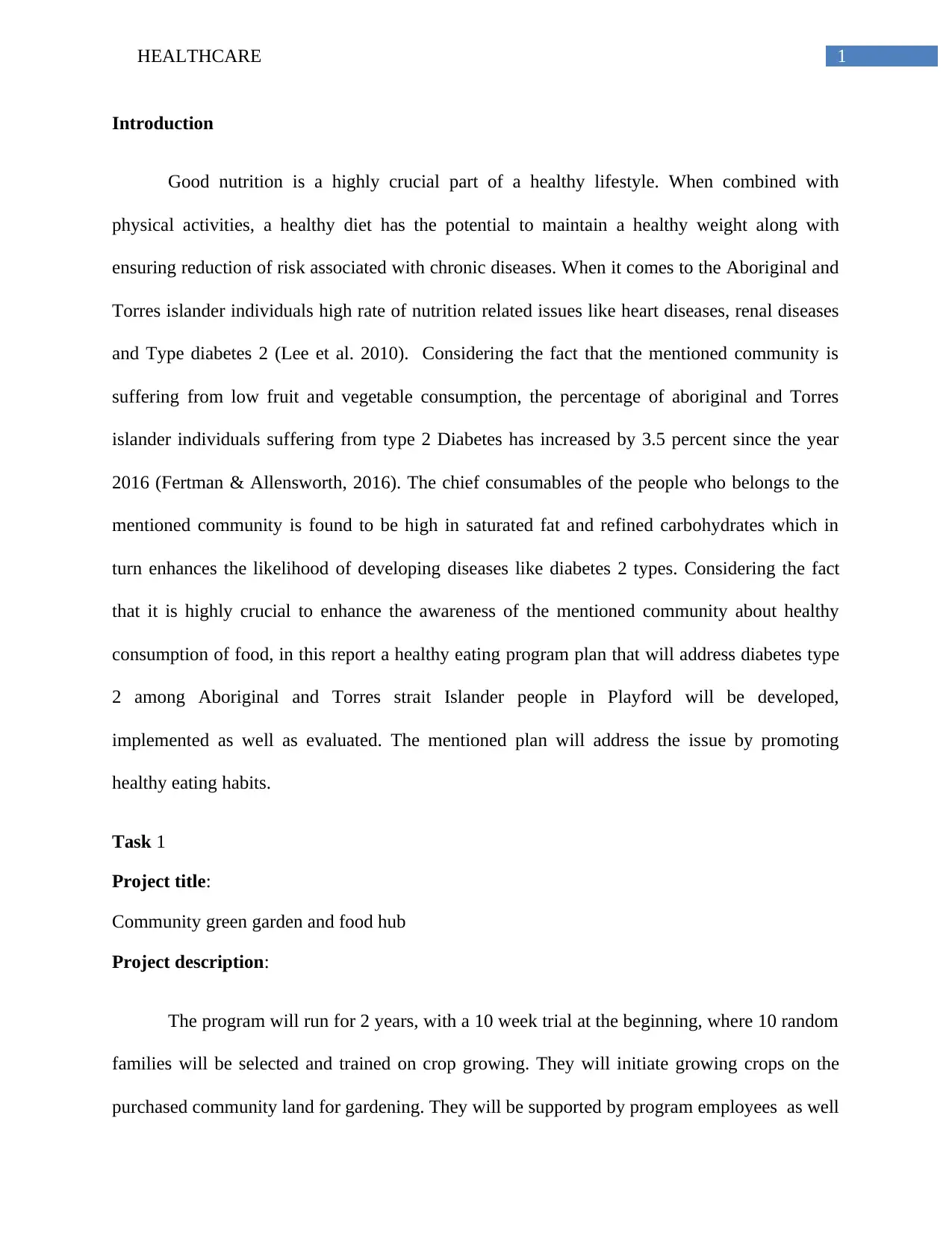
1HEALTHCARE
Introduction
Good nutrition is a highly crucial part of a healthy lifestyle. When combined with
physical activities, a healthy diet has the potential to maintain a healthy weight along with
ensuring reduction of risk associated with chronic diseases. When it comes to the Aboriginal and
Torres islander individuals high rate of nutrition related issues like heart diseases, renal diseases
and Type diabetes 2 (Lee et al. 2010). Considering the fact that the mentioned community is
suffering from low fruit and vegetable consumption, the percentage of aboriginal and Torres
islander individuals suffering from type 2 Diabetes has increased by 3.5 percent since the year
2016 (Fertman & Allensworth, 2016). The chief consumables of the people who belongs to the
mentioned community is found to be high in saturated fat and refined carbohydrates which in
turn enhances the likelihood of developing diseases like diabetes 2 types. Considering the fact
that it is highly crucial to enhance the awareness of the mentioned community about healthy
consumption of food, in this report a healthy eating program plan that will address diabetes type
2 among Aboriginal and Torres strait Islander people in Playford will be developed,
implemented as well as evaluated. The mentioned plan will address the issue by promoting
healthy eating habits.
Task 1
Project title:
Community green garden and food hub
Project description:
The program will run for 2 years, with a 10 week trial at the beginning, where 10 random
families will be selected and trained on crop growing. They will initiate growing crops on the
purchased community land for gardening. They will be supported by program employees as well
Introduction
Good nutrition is a highly crucial part of a healthy lifestyle. When combined with
physical activities, a healthy diet has the potential to maintain a healthy weight along with
ensuring reduction of risk associated with chronic diseases. When it comes to the Aboriginal and
Torres islander individuals high rate of nutrition related issues like heart diseases, renal diseases
and Type diabetes 2 (Lee et al. 2010). Considering the fact that the mentioned community is
suffering from low fruit and vegetable consumption, the percentage of aboriginal and Torres
islander individuals suffering from type 2 Diabetes has increased by 3.5 percent since the year
2016 (Fertman & Allensworth, 2016). The chief consumables of the people who belongs to the
mentioned community is found to be high in saturated fat and refined carbohydrates which in
turn enhances the likelihood of developing diseases like diabetes 2 types. Considering the fact
that it is highly crucial to enhance the awareness of the mentioned community about healthy
consumption of food, in this report a healthy eating program plan that will address diabetes type
2 among Aboriginal and Torres strait Islander people in Playford will be developed,
implemented as well as evaluated. The mentioned plan will address the issue by promoting
healthy eating habits.
Task 1
Project title:
Community green garden and food hub
Project description:
The program will run for 2 years, with a 10 week trial at the beginning, where 10 random
families will be selected and trained on crop growing. They will initiate growing crops on the
purchased community land for gardening. They will be supported by program employees as well
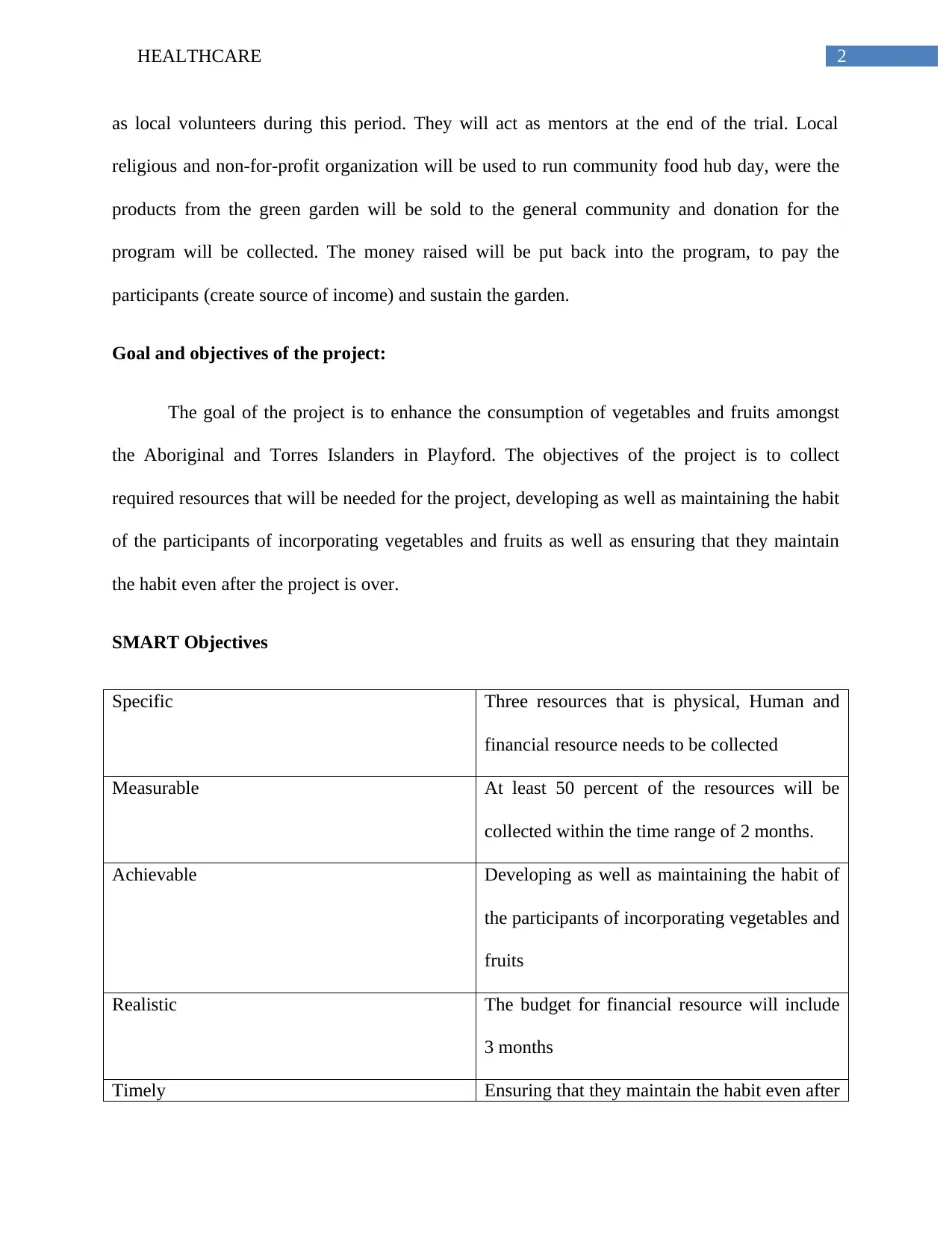
2HEALTHCARE
as local volunteers during this period. They will act as mentors at the end of the trial. Local
religious and non-for-profit organization will be used to run community food hub day, were the
products from the green garden will be sold to the general community and donation for the
program will be collected. The money raised will be put back into the program, to pay the
participants (create source of income) and sustain the garden.
Goal and objectives of the project:
The goal of the project is to enhance the consumption of vegetables and fruits amongst
the Aboriginal and Torres Islanders in Playford. The objectives of the project is to collect
required resources that will be needed for the project, developing as well as maintaining the habit
of the participants of incorporating vegetables and fruits as well as ensuring that they maintain
the habit even after the project is over.
SMART Objectives
Specific Three resources that is physical, Human and
financial resource needs to be collected
Measurable At least 50 percent of the resources will be
collected within the time range of 2 months.
Achievable Developing as well as maintaining the habit of
the participants of incorporating vegetables and
fruits
Realistic The budget for financial resource will include
3 months
Timely Ensuring that they maintain the habit even after
as local volunteers during this period. They will act as mentors at the end of the trial. Local
religious and non-for-profit organization will be used to run community food hub day, were the
products from the green garden will be sold to the general community and donation for the
program will be collected. The money raised will be put back into the program, to pay the
participants (create source of income) and sustain the garden.
Goal and objectives of the project:
The goal of the project is to enhance the consumption of vegetables and fruits amongst
the Aboriginal and Torres Islanders in Playford. The objectives of the project is to collect
required resources that will be needed for the project, developing as well as maintaining the habit
of the participants of incorporating vegetables and fruits as well as ensuring that they maintain
the habit even after the project is over.
SMART Objectives
Specific Three resources that is physical, Human and
financial resource needs to be collected
Measurable At least 50 percent of the resources will be
collected within the time range of 2 months.
Achievable Developing as well as maintaining the habit of
the participants of incorporating vegetables and
fruits
Realistic The budget for financial resource will include
3 months
Timely Ensuring that they maintain the habit even after
⊘ This is a preview!⊘
Do you want full access?
Subscribe today to unlock all pages.

Trusted by 1+ million students worldwide

3HEALTHCARE
the project is over
the project is over
Paraphrase This Document
Need a fresh take? Get an instant paraphrase of this document with our AI Paraphraser
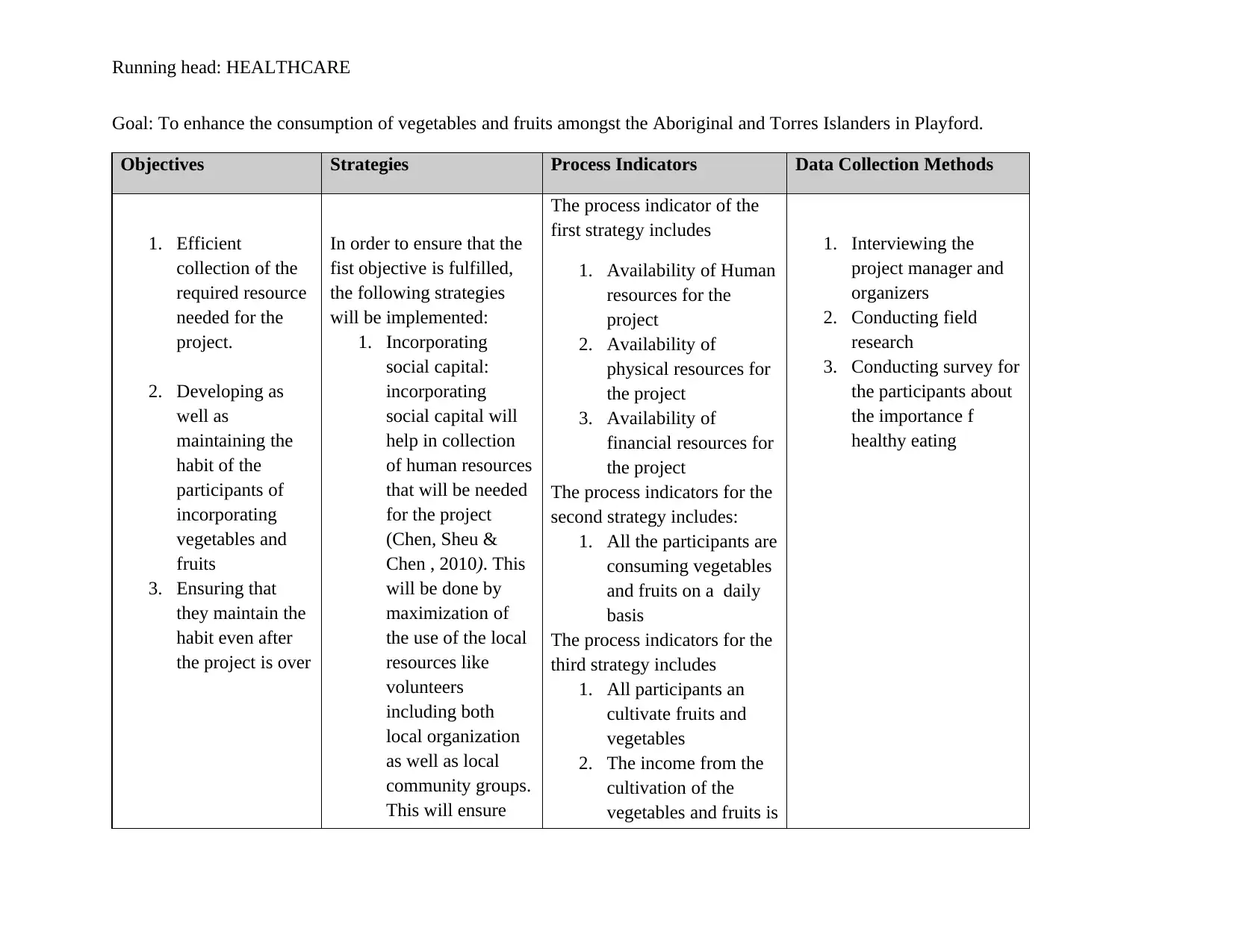
Running head: HEALTHCARE
Goal: To enhance the consumption of vegetables and fruits amongst the Aboriginal and Torres Islanders in Playford.
Objectives Strategies Process Indicators Data Collection Methods
1. Efficient
collection of the
required resource
needed for the
project.
2. Developing as
well as
maintaining the
habit of the
participants of
incorporating
vegetables and
fruits
3. Ensuring that
they maintain the
habit even after
the project is over
In order to ensure that the
fist objective is fulfilled,
the following strategies
will be implemented:
1. Incorporating
social capital:
incorporating
social capital will
help in collection
of human resources
that will be needed
for the project
(Chen, Sheu &
Chen , 2010). This
will be done by
maximization of
the use of the local
resources like
volunteers
including both
local organization
as well as local
community groups.
This will ensure
The process indicator of the
first strategy includes
1. Availability of Human
resources for the
project
2. Availability of
physical resources for
the project
3. Availability of
financial resources for
the project
The process indicators for the
second strategy includes:
1. All the participants are
consuming vegetables
and fruits on a daily
basis
The process indicators for the
third strategy includes
1. All participants an
cultivate fruits and
vegetables
2. The income from the
cultivation of the
vegetables and fruits is
1. Interviewing the
project manager and
organizers
2. Conducting field
research
3. Conducting survey for
the participants about
the importance f
healthy eating
Goal: To enhance the consumption of vegetables and fruits amongst the Aboriginal and Torres Islanders in Playford.
Objectives Strategies Process Indicators Data Collection Methods
1. Efficient
collection of the
required resource
needed for the
project.
2. Developing as
well as
maintaining the
habit of the
participants of
incorporating
vegetables and
fruits
3. Ensuring that
they maintain the
habit even after
the project is over
In order to ensure that the
fist objective is fulfilled,
the following strategies
will be implemented:
1. Incorporating
social capital:
incorporating
social capital will
help in collection
of human resources
that will be needed
for the project
(Chen, Sheu &
Chen , 2010). This
will be done by
maximization of
the use of the local
resources like
volunteers
including both
local organization
as well as local
community groups.
This will ensure
The process indicator of the
first strategy includes
1. Availability of Human
resources for the
project
2. Availability of
physical resources for
the project
3. Availability of
financial resources for
the project
The process indicators for the
second strategy includes:
1. All the participants are
consuming vegetables
and fruits on a daily
basis
The process indicators for the
third strategy includes
1. All participants an
cultivate fruits and
vegetables
2. The income from the
cultivation of the
vegetables and fruits is
1. Interviewing the
project manager and
organizers
2. Conducting field
research
3. Conducting survey for
the participants about
the importance f
healthy eating
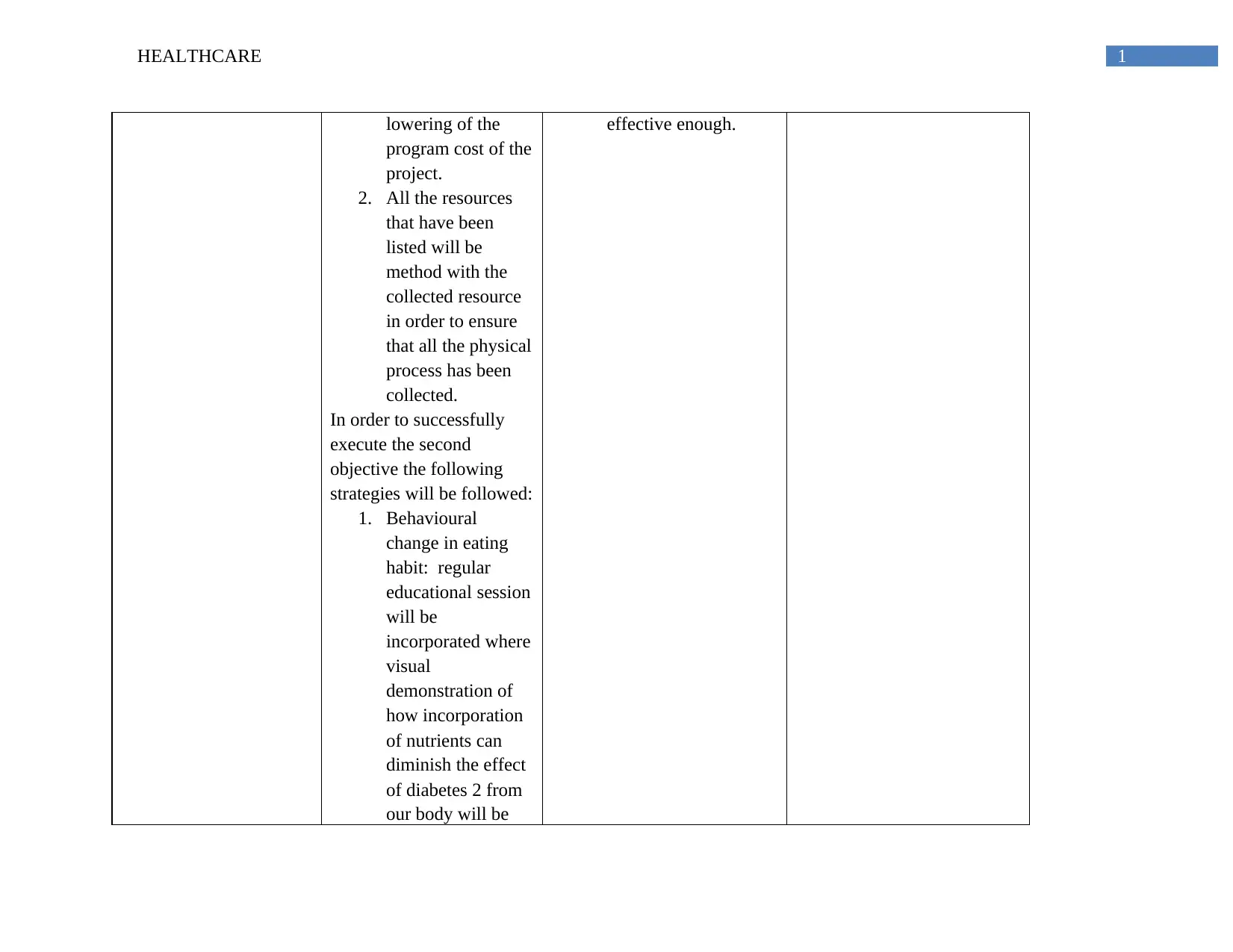
1HEALTHCARE
lowering of the
program cost of the
project.
2. All the resources
that have been
listed will be
method with the
collected resource
in order to ensure
that all the physical
process has been
collected.
In order to successfully
execute the second
objective the following
strategies will be followed:
1. Behavioural
change in eating
habit: regular
educational session
will be
incorporated where
visual
demonstration of
how incorporation
of nutrients can
diminish the effect
of diabetes 2 from
our body will be
effective enough.
lowering of the
program cost of the
project.
2. All the resources
that have been
listed will be
method with the
collected resource
in order to ensure
that all the physical
process has been
collected.
In order to successfully
execute the second
objective the following
strategies will be followed:
1. Behavioural
change in eating
habit: regular
educational session
will be
incorporated where
visual
demonstration of
how incorporation
of nutrients can
diminish the effect
of diabetes 2 from
our body will be
effective enough.
⊘ This is a preview!⊘
Do you want full access?
Subscribe today to unlock all pages.

Trusted by 1+ million students worldwide
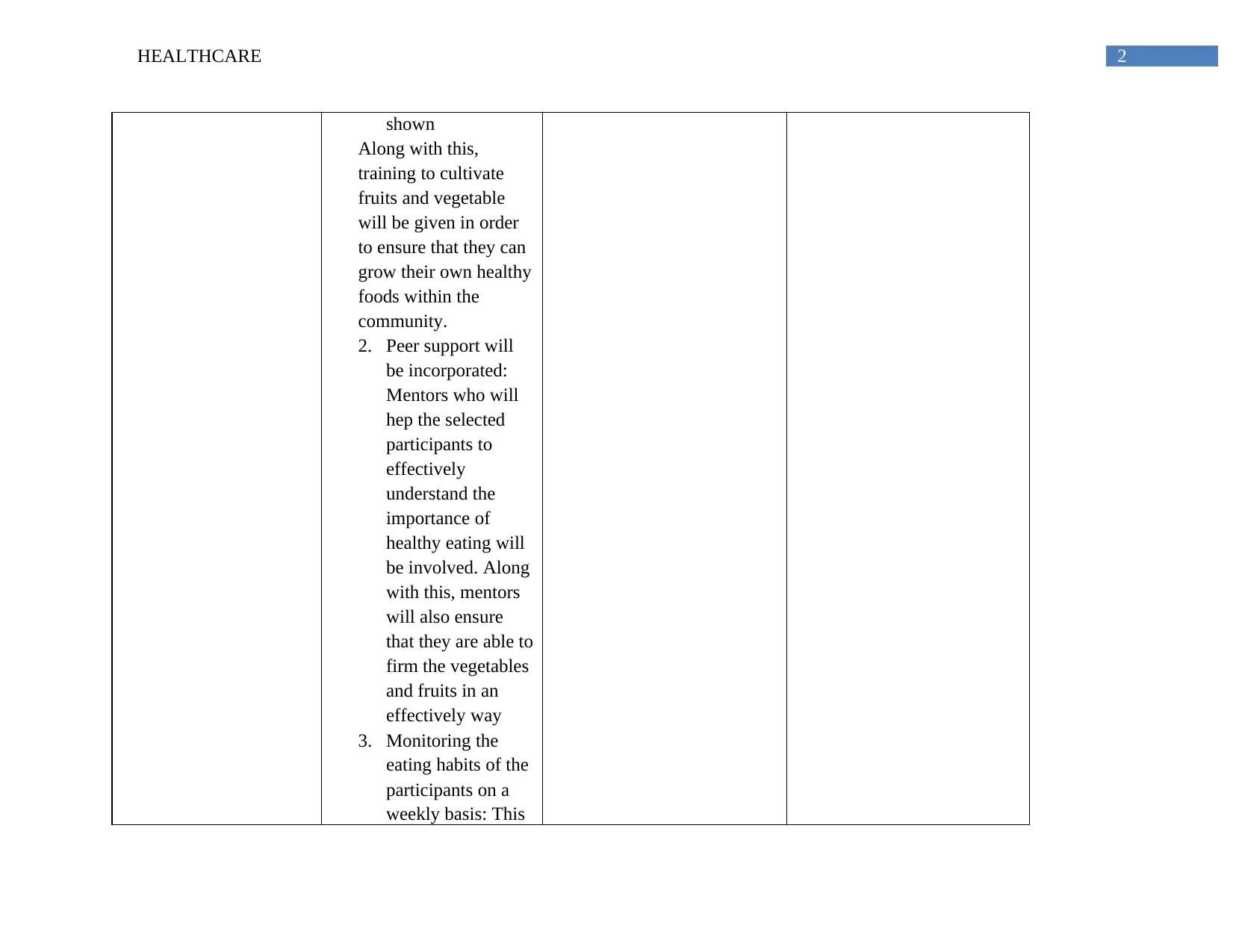
2HEALTHCARE
shown
Along with this,
training to cultivate
fruits and vegetable
will be given in order
to ensure that they can
grow their own healthy
foods within the
community.
2. Peer support will
be incorporated:
Mentors who will
hep the selected
participants to
effectively
understand the
importance of
healthy eating will
be involved. Along
with this, mentors
will also ensure
that they are able to
firm the vegetables
and fruits in an
effectively way
3. Monitoring the
eating habits of the
participants on a
weekly basis: This
shown
Along with this,
training to cultivate
fruits and vegetable
will be given in order
to ensure that they can
grow their own healthy
foods within the
community.
2. Peer support will
be incorporated:
Mentors who will
hep the selected
participants to
effectively
understand the
importance of
healthy eating will
be involved. Along
with this, mentors
will also ensure
that they are able to
firm the vegetables
and fruits in an
effectively way
3. Monitoring the
eating habits of the
participants on a
weekly basis: This
Paraphrase This Document
Need a fresh take? Get an instant paraphrase of this document with our AI Paraphraser
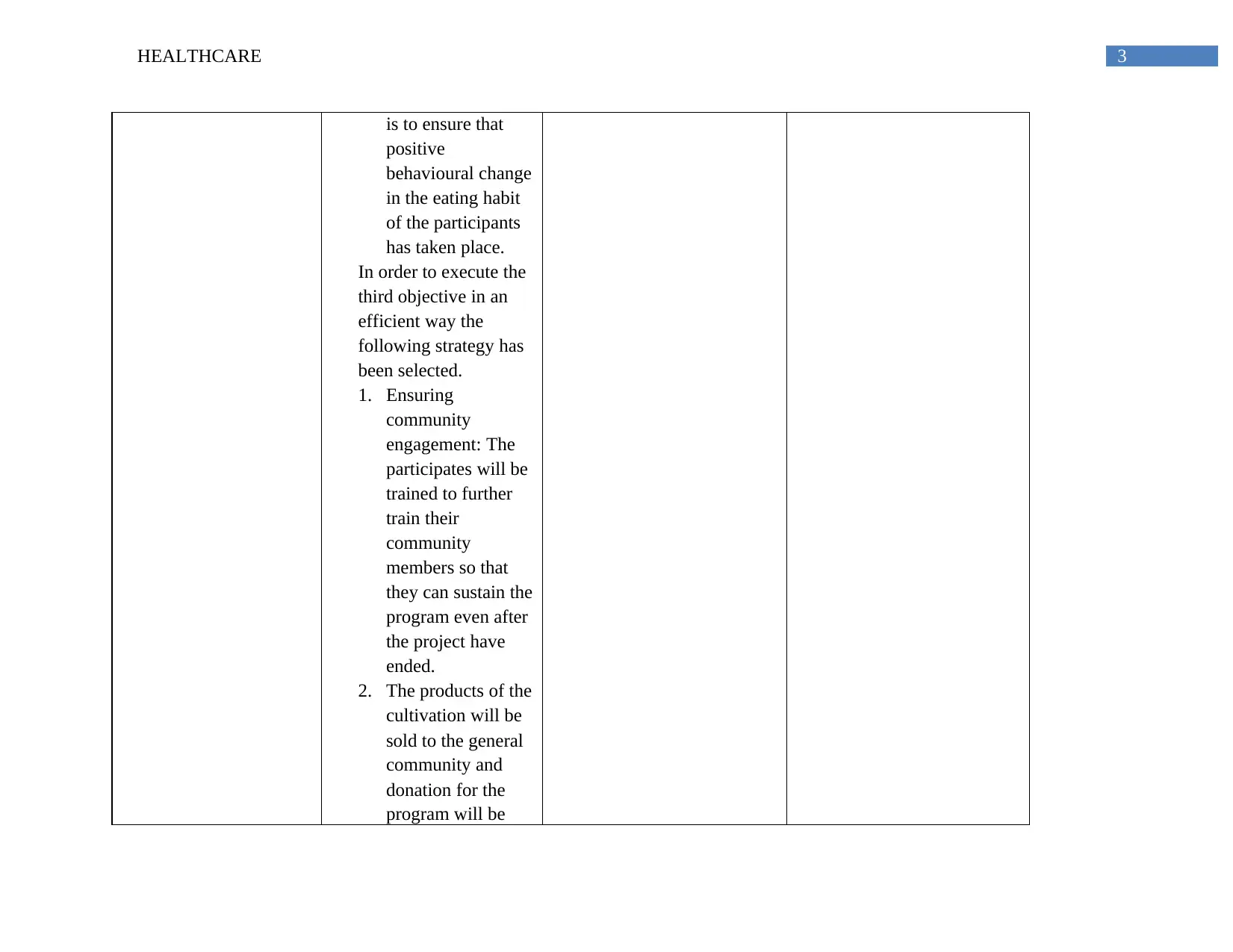
3HEALTHCARE
is to ensure that
positive
behavioural change
in the eating habit
of the participants
has taken place.
In order to execute the
third objective in an
efficient way the
following strategy has
been selected.
1. Ensuring
community
engagement: The
participates will be
trained to further
train their
community
members so that
they can sustain the
program even after
the project have
ended.
2. The products of the
cultivation will be
sold to the general
community and
donation for the
program will be
is to ensure that
positive
behavioural change
in the eating habit
of the participants
has taken place.
In order to execute the
third objective in an
efficient way the
following strategy has
been selected.
1. Ensuring
community
engagement: The
participates will be
trained to further
train their
community
members so that
they can sustain the
program even after
the project have
ended.
2. The products of the
cultivation will be
sold to the general
community and
donation for the
program will be
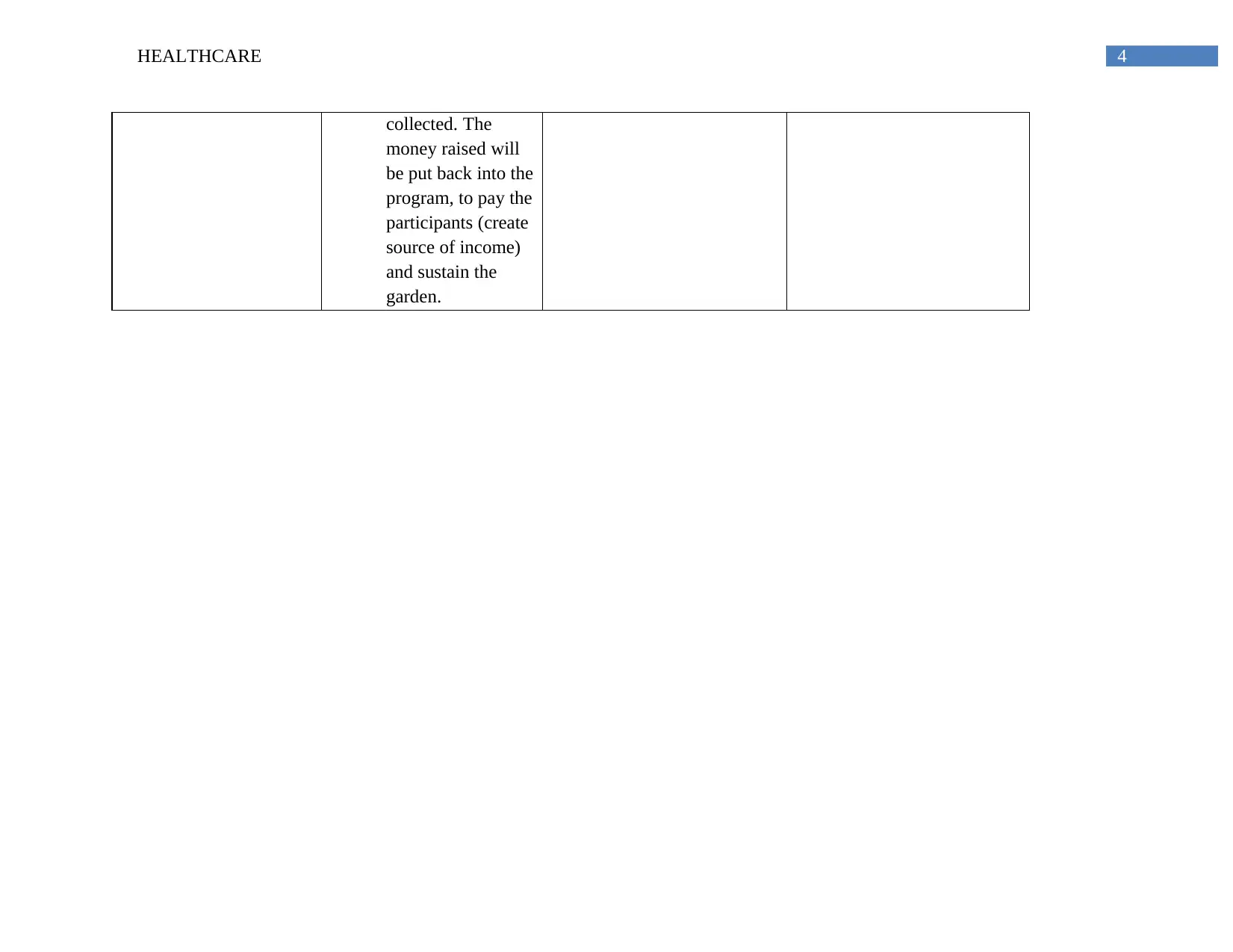
4HEALTHCARE
collected. The
money raised will
be put back into the
program, to pay the
participants (create
source of income)
and sustain the
garden.
collected. The
money raised will
be put back into the
program, to pay the
participants (create
source of income)
and sustain the
garden.
⊘ This is a preview!⊘
Do you want full access?
Subscribe today to unlock all pages.

Trusted by 1+ million students worldwide
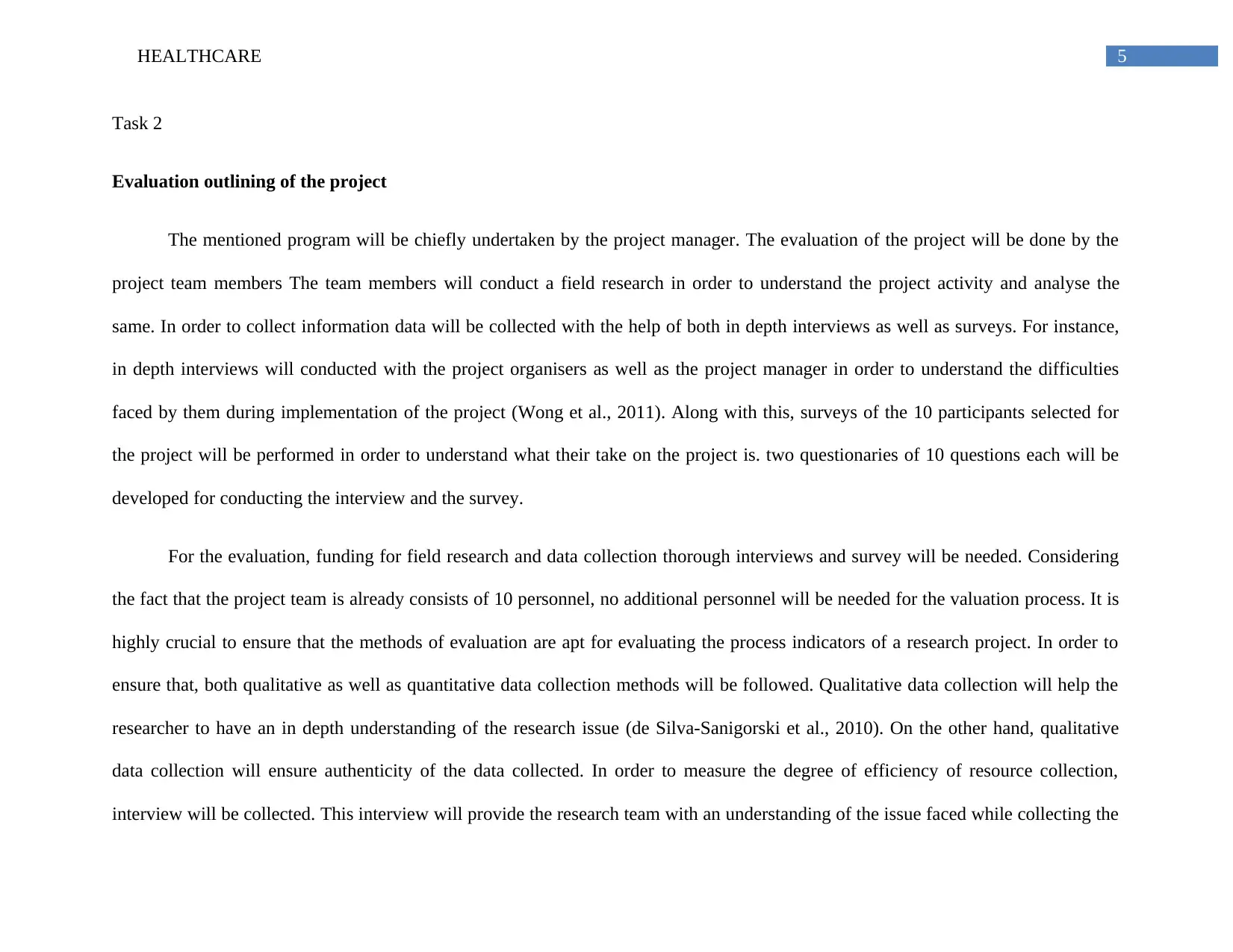
5HEALTHCARE
Task 2
Evaluation outlining of the project
The mentioned program will be chiefly undertaken by the project manager. The evaluation of the project will be done by the
project team members The team members will conduct a field research in order to understand the project activity and analyse the
same. In order to collect information data will be collected with the help of both in depth interviews as well as surveys. For instance,
in depth interviews will conducted with the project organisers as well as the project manager in order to understand the difficulties
faced by them during implementation of the project (Wong et al., 2011). Along with this, surveys of the 10 participants selected for
the project will be performed in order to understand what their take on the project is. two questionaries of 10 questions each will be
developed for conducting the interview and the survey.
For the evaluation, funding for field research and data collection thorough interviews and survey will be needed. Considering
the fact that the project team is already consists of 10 personnel, no additional personnel will be needed for the valuation process. It is
highly crucial to ensure that the methods of evaluation are apt for evaluating the process indicators of a research project. In order to
ensure that, both qualitative as well as quantitative data collection methods will be followed. Qualitative data collection will help the
researcher to have an in depth understanding of the research issue (de Silva-Sanigorski et al., 2010). On the other hand, qualitative
data collection will ensure authenticity of the data collected. In order to measure the degree of efficiency of resource collection,
interview will be collected. This interview will provide the research team with an understanding of the issue faced while collecting the
Task 2
Evaluation outlining of the project
The mentioned program will be chiefly undertaken by the project manager. The evaluation of the project will be done by the
project team members The team members will conduct a field research in order to understand the project activity and analyse the
same. In order to collect information data will be collected with the help of both in depth interviews as well as surveys. For instance,
in depth interviews will conducted with the project organisers as well as the project manager in order to understand the difficulties
faced by them during implementation of the project (Wong et al., 2011). Along with this, surveys of the 10 participants selected for
the project will be performed in order to understand what their take on the project is. two questionaries of 10 questions each will be
developed for conducting the interview and the survey.
For the evaluation, funding for field research and data collection thorough interviews and survey will be needed. Considering
the fact that the project team is already consists of 10 personnel, no additional personnel will be needed for the valuation process. It is
highly crucial to ensure that the methods of evaluation are apt for evaluating the process indicators of a research project. In order to
ensure that, both qualitative as well as quantitative data collection methods will be followed. Qualitative data collection will help the
researcher to have an in depth understanding of the research issue (de Silva-Sanigorski et al., 2010). On the other hand, qualitative
data collection will ensure authenticity of the data collected. In order to measure the degree of efficiency of resource collection,
interview will be collected. This interview will provide the research team with an understanding of the issue faced while collecting the
Paraphrase This Document
Need a fresh take? Get an instant paraphrase of this document with our AI Paraphraser
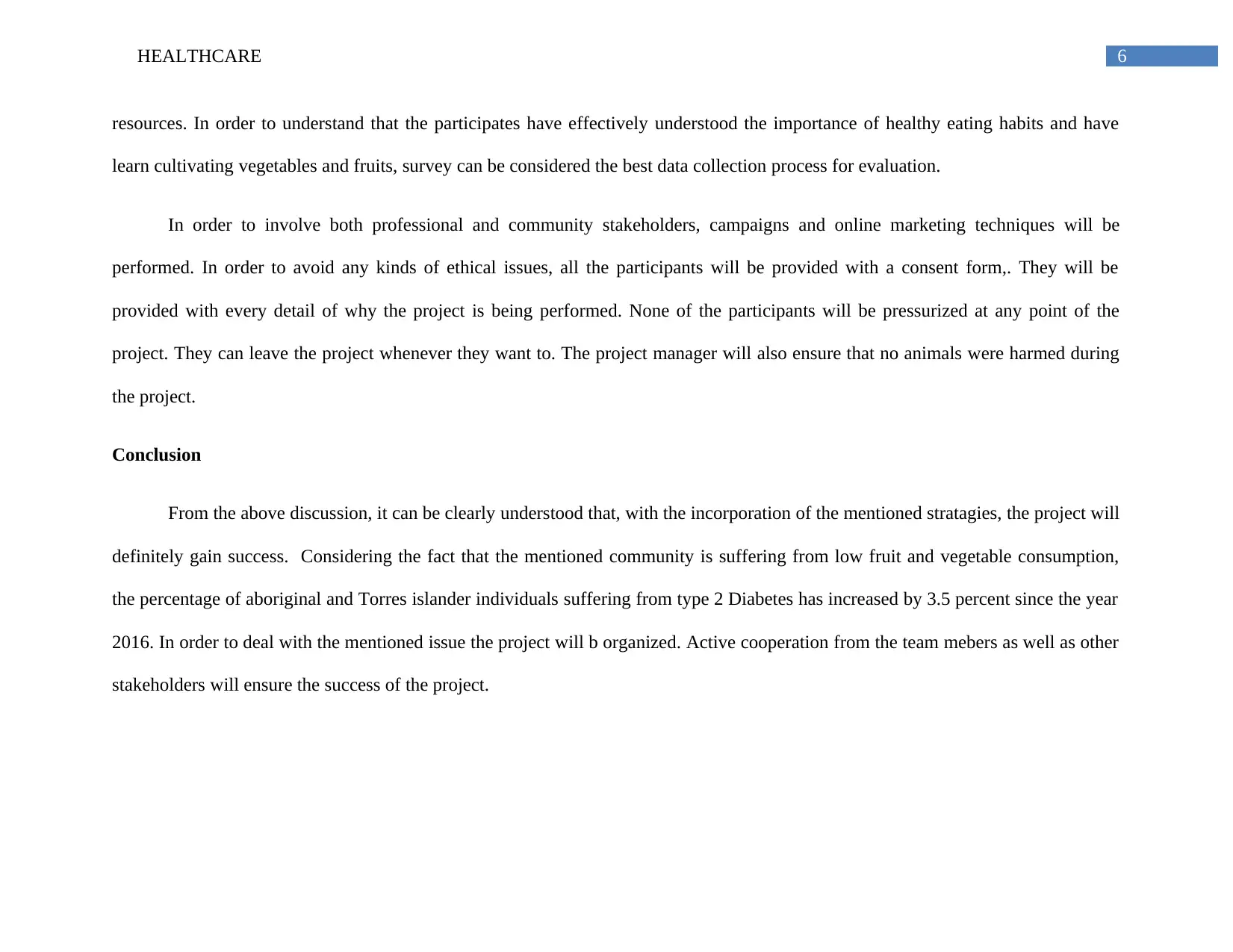
6HEALTHCARE
resources. In order to understand that the participates have effectively understood the importance of healthy eating habits and have
learn cultivating vegetables and fruits, survey can be considered the best data collection process for evaluation.
In order to involve both professional and community stakeholders, campaigns and online marketing techniques will be
performed. In order to avoid any kinds of ethical issues, all the participants will be provided with a consent form,. They will be
provided with every detail of why the project is being performed. None of the participants will be pressurized at any point of the
project. They can leave the project whenever they want to. The project manager will also ensure that no animals were harmed during
the project.
Conclusion
From the above discussion, it can be clearly understood that, with the incorporation of the mentioned stratagies, the project will
definitely gain success. Considering the fact that the mentioned community is suffering from low fruit and vegetable consumption,
the percentage of aboriginal and Torres islander individuals suffering from type 2 Diabetes has increased by 3.5 percent since the year
2016. In order to deal with the mentioned issue the project will b organized. Active cooperation from the team mebers as well as other
stakeholders will ensure the success of the project.
resources. In order to understand that the participates have effectively understood the importance of healthy eating habits and have
learn cultivating vegetables and fruits, survey can be considered the best data collection process for evaluation.
In order to involve both professional and community stakeholders, campaigns and online marketing techniques will be
performed. In order to avoid any kinds of ethical issues, all the participants will be provided with a consent form,. They will be
provided with every detail of why the project is being performed. None of the participants will be pressurized at any point of the
project. They can leave the project whenever they want to. The project manager will also ensure that no animals were harmed during
the project.
Conclusion
From the above discussion, it can be clearly understood that, with the incorporation of the mentioned stratagies, the project will
definitely gain success. Considering the fact that the mentioned community is suffering from low fruit and vegetable consumption,
the percentage of aboriginal and Torres islander individuals suffering from type 2 Diabetes has increased by 3.5 percent since the year
2016. In order to deal with the mentioned issue the project will b organized. Active cooperation from the team mebers as well as other
stakeholders will ensure the success of the project.
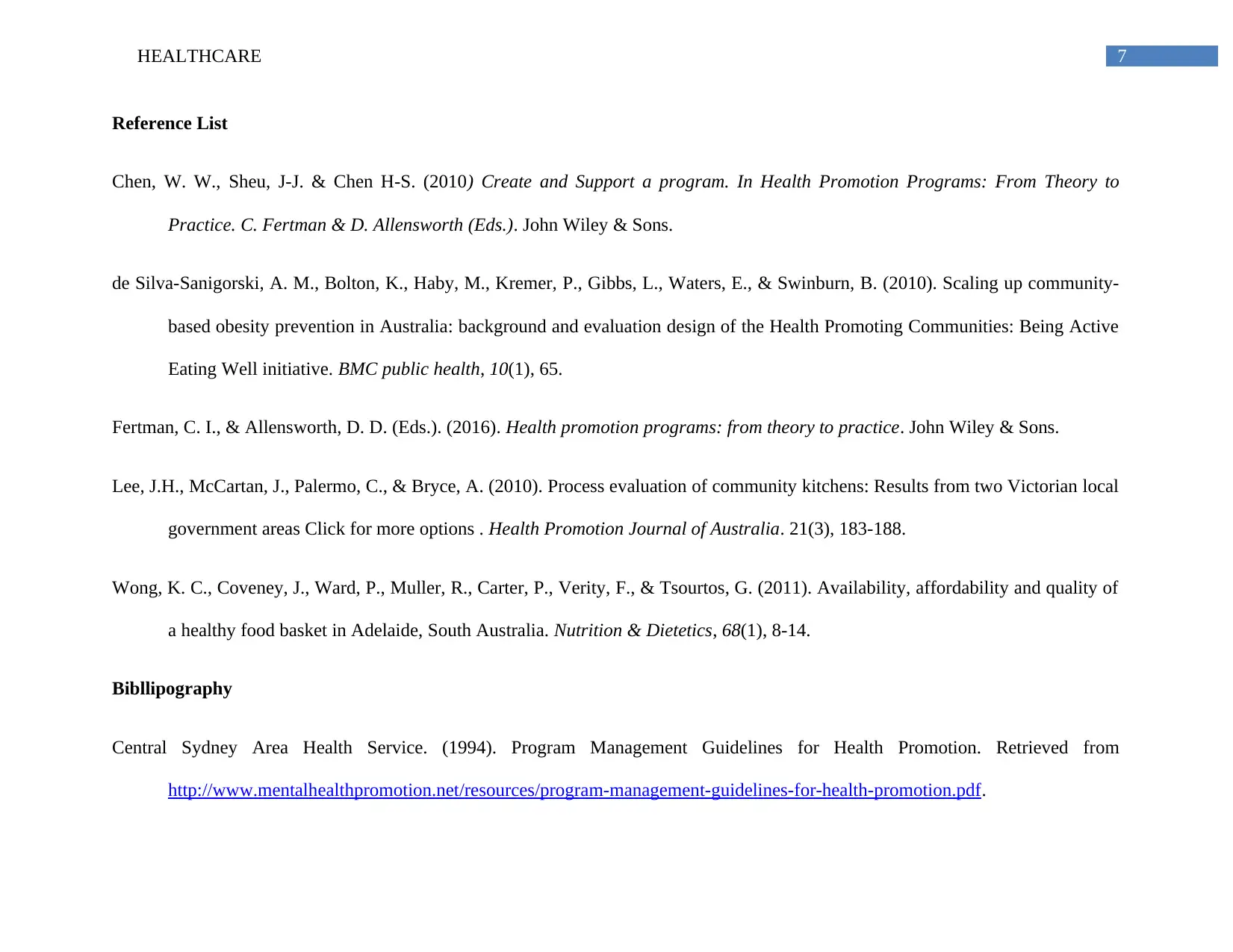
7HEALTHCARE
Reference List
Chen, W. W., Sheu, J-J. & Chen H-S. (2010) Create and Support a program. In Health Promotion Programs: From Theory to
Practice. C. Fertman & D. Allensworth (Eds.). John Wiley & Sons.
de Silva-Sanigorski, A. M., Bolton, K., Haby, M., Kremer, P., Gibbs, L., Waters, E., & Swinburn, B. (2010). Scaling up community-
based obesity prevention in Australia: background and evaluation design of the Health Promoting Communities: Being Active
Eating Well initiative. BMC public health, 10(1), 65.
Fertman, C. I., & Allensworth, D. D. (Eds.). (2016). Health promotion programs: from theory to practice. John Wiley & Sons.
Lee, J.H., McCartan, J., Palermo, C., & Bryce, A. (2010). Process evaluation of community kitchens: Results from two Victorian local
government areas Click for more options . Health Promotion Journal of Australia. 21(3), 183-188.
Wong, K. C., Coveney, J., Ward, P., Muller, R., Carter, P., Verity, F., & Tsourtos, G. (2011). Availability, affordability and quality of
a healthy food basket in Adelaide, South Australia. Nutrition & Dietetics, 68(1), 8-14.
Bibllipography
Central Sydney Area Health Service. (1994). Program Management Guidelines for Health Promotion. Retrieved from
http://www.mentalhealthpromotion.net/resources/program-management-guidelines-for-health-promotion.pdf.
Reference List
Chen, W. W., Sheu, J-J. & Chen H-S. (2010) Create and Support a program. In Health Promotion Programs: From Theory to
Practice. C. Fertman & D. Allensworth (Eds.). John Wiley & Sons.
de Silva-Sanigorski, A. M., Bolton, K., Haby, M., Kremer, P., Gibbs, L., Waters, E., & Swinburn, B. (2010). Scaling up community-
based obesity prevention in Australia: background and evaluation design of the Health Promoting Communities: Being Active
Eating Well initiative. BMC public health, 10(1), 65.
Fertman, C. I., & Allensworth, D. D. (Eds.). (2016). Health promotion programs: from theory to practice. John Wiley & Sons.
Lee, J.H., McCartan, J., Palermo, C., & Bryce, A. (2010). Process evaluation of community kitchens: Results from two Victorian local
government areas Click for more options . Health Promotion Journal of Australia. 21(3), 183-188.
Wong, K. C., Coveney, J., Ward, P., Muller, R., Carter, P., Verity, F., & Tsourtos, G. (2011). Availability, affordability and quality of
a healthy food basket in Adelaide, South Australia. Nutrition & Dietetics, 68(1), 8-14.
Bibllipography
Central Sydney Area Health Service. (1994). Program Management Guidelines for Health Promotion. Retrieved from
http://www.mentalhealthpromotion.net/resources/program-management-guidelines-for-health-promotion.pdf.
⊘ This is a preview!⊘
Do you want full access?
Subscribe today to unlock all pages.

Trusted by 1+ million students worldwide
1 out of 13
Related Documents
Your All-in-One AI-Powered Toolkit for Academic Success.
+13062052269
info@desklib.com
Available 24*7 on WhatsApp / Email
![[object Object]](/_next/static/media/star-bottom.7253800d.svg)
Unlock your academic potential
Copyright © 2020–2025 A2Z Services. All Rights Reserved. Developed and managed by ZUCOL.




